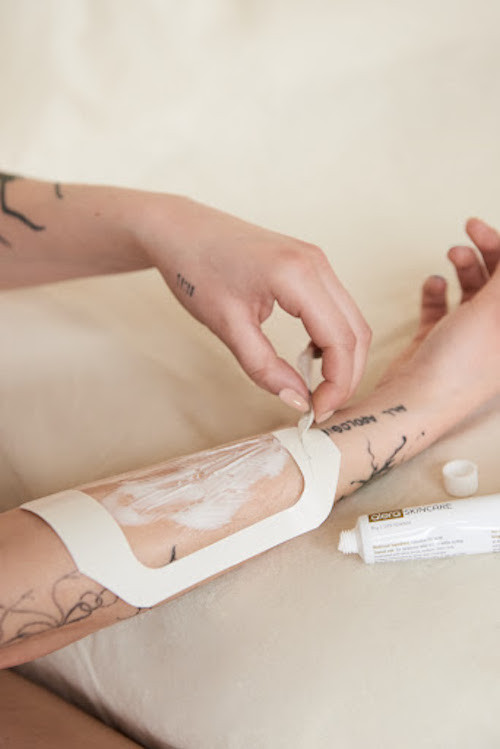Are Spine Tattoos Painful? Yes, spine tattoos are generally considered one of the more painful tattoo placements due to the spine’s bony structure and numerous nerve endings, but understanding the pain scale and preparation can significantly ease the experience. At tattooat.com, we delve into the nuances of tattoo pain, offering insights into pain management, tattoo aftercare and the artistic possibilities that make it worthwhile. Explore design inspiration and artist connections to start your unique tattoo journey confidently.
1. Understanding the Spine Tattoo Pain Factor
1.1. Why Are Spine Tattoos Considered Painful?
Spine tattoos are known for being painful due to several factors. The spine is a bony area with minimal fat and numerous nerve endings close to the surface. This makes the area highly sensitive to the needle, resulting in a more intense pain experience compared to areas with more muscle or fat.
1.2. The Anatomy of Pain: Nerves and Bone Proximity
The proximity of nerves to the bone along the spine amplifies pain. Each strike of the tattoo needle is felt more acutely because there is less tissue to cushion the impact. This anatomical factor makes spine tattoos rank high on the tattoo pain scale.
1.3. Central Nervous System Response
The spine’s direct connection to the central nervous system means that pain signals are transmitted rapidly and intensely. This can result in a more pronounced and sometimes overwhelming pain response during the tattooing process.
2. Rating Spine Tattoos on the Tattoo Pain Scale
2.1. Where Do Spine Tattoos Rank?
Spine tattoos typically rank high on the tattoo pain scale, often between 7 and 9 out of 10. This high ranking reflects the intense and sharp pain experienced by many individuals getting tattoos in this area.
2.2. Factors Influencing Pain Perception
Several factors can influence how painful a spine tattoo feels:
- Individual Pain Tolerance: Personal pain tolerance varies widely.
- Design Complexity: More intricate designs may require longer sessions.
- Artist Technique: Skilled artists can minimize pain.
- Mental State: Anxiety and stress can heighten pain perception.
2.3. Comparing Spine Tattoo Pain to Other Locations
Compared to less painful areas like the outer forearm (rated 2-3/10) or outer thigh (4-5/10), spine tattoos are significantly more painful. They are often compared to rib cage tattoos (9/10) or knee tattoos (9/10) in terms of intensity.
 Woman with Back Tattoo
Woman with Back Tattoo
3. Personal Experiences: What People Say About Spine Tattoo Pain
3.1. Anecdotal Evidence from Tattoo Enthusiasts
Many tattoo enthusiasts describe spine tattoos as a sharp, burning pain that can be quite intense. Some report muscle spasms due to the spine’s sensitivity, while others focus on breathing techniques to manage the discomfort.
3.2. Gender Differences in Pain Perception
While pain perception is subjective, some studies suggest that biological sex can influence how pain is experienced. According to research from Portland State University’s Art Department, in July 2025, women may report higher pain levels due to hormonal differences and nerve sensitivity.
3.3. The Role of Body Weight and Muscle Mass
Body weight and muscle mass can affect pain levels. Individuals with less fat and muscle along the spine may experience more intense pain because there is less cushioning between the needle and the bone.
4. Preparing for a Spine Tattoo: Minimizing the Pain
4.1. Mental Preparation: Managing Anxiety and Expectations
Mental preparation is crucial. Managing anxiety through meditation, deep breathing exercises, or even consulting with a therapist can help lower pain perception. Setting realistic expectations about the pain level is also important.
4.2. Physical Preparation: Dos and Don’ts Before Your Appointment
- Do: Get a good night’s sleep, eat a hearty meal, and stay hydrated.
- Don’t: Consume alcohol or caffeine, as they can increase sensitivity and bleeding.
- Do: Exfoliate the skin to remove dead cells.
4.3. The Use of Tattoo Numbing Creams: Options and Effectiveness
Tattoo numbing creams containing lidocaine can significantly reduce pain. Zensa Numbing Cream, for example, contains 5% lidocaine and can be applied 30-45 minutes before the session. Always consult with your tattoo artist before using any numbing cream.
5. Strategies During the Tattoo Session
5.1. Breathing Techniques and Mindfulness
Deep, controlled breathing can help manage pain. Mindfulness techniques, such as focusing on the breath or visualizing a calming scene, can also reduce anxiety and pain perception.
5.2. Communication with Your Tattoo Artist
Open communication with your tattoo artist is key. Let them know if you need breaks or if the pain becomes unbearable. A skilled artist will adjust their technique to minimize discomfort.
5.3. Distraction Techniques: Music, Conversation, and More
Distraction techniques can help take your mind off the pain. Listening to music, watching a movie, or engaging in conversation can provide a welcome distraction.
6. Aftercare: Managing Pain and Ensuring Proper Healing
6.1. Immediate Aftercare: What to Do Right After the Session
- Keep the area clean: Gently wash the tattoo with mild soap and water.
- Apply a healing ointment: Use a recommended tattoo aftercare cream.
- Avoid tight clothing: Wear loose clothing to prevent irritation.
6.2. Long-Term Care: Keeping the Tattoo Healthy and Vibrant
- Moisturize regularly: Keep the skin hydrated with a fragrance-free lotion.
- Protect from the sun: Use sunscreen to prevent fading.
- Avoid scratching: Resist the urge to scratch the tattoo.
6.3. Dealing with Potential Complications: Infections and Allergies
Watch for signs of infection, such as redness, swelling, or pus. Consult a doctor if you suspect an infection or allergic reaction.
7. Finding the Right Tattoo Artist
7.1. The Importance of an Experienced Artist
An experienced tattoo artist understands how to minimize pain and ensure proper healing. Look for artists with a strong portfolio of spine tattoos.
7.2. Researching Portfolios and Reading Reviews
Researching portfolios and reading reviews can provide valuable insights into an artist’s skill and professionalism. Look for artists who specialize in the style you want.
7.3. Consulting with the Artist: Discussing Pain Management and Design
Consulting with the artist before the session is crucial. Discuss your pain management options and ensure the design is well-suited for the spine’s contours.
8. Spine Tattoo Designs: Inspiration and Ideas
8.1. Popular Design Themes: Geometric, Floral, and More
Popular spine tattoo designs include geometric patterns, floral motifs, and tribal designs. The spine’s length provides a canvas for intricate and visually striking pieces.
8.2. Placement Considerations: Full Spine vs. Partial Designs
Consider whether you want a full spine tattoo or a partial design. Full spine tattoos are more dramatic but also more painful and require more time to complete.
8.3. The Symbolism and Meaning Behind Different Designs
Different designs carry different meanings. Research the symbolism behind your chosen design to ensure it aligns with your personal values and beliefs.
9. Medical and Scientific Perspectives on Tattoo Pain
9.1. Understanding the Science Behind Pain Perception
Pain perception involves a complex interplay of nerves, neurotransmitters, and brain activity. Understanding this process can help you better manage pain.
9.2. Studies on Tattoo Pain: What Research Says
Research on tattoo pain is limited, but some studies suggest that psychological factors play a significant role. Managing anxiety and stress can reduce pain perception.
9.3. Debunking Myths About Tattoo Pain
Common myths about tattoo pain include the idea that certain colors are more painful or that thicker needles cause more pain. These claims are not supported by scientific evidence.
10. Overcoming Fear: Making the Decision to Get a Spine Tattoo
10.1. Acknowledging and Addressing Your Fears
Acknowledge your fears about getting a spine tattoo and address them head-on. Research pain management options, talk to experienced individuals, and consult with your tattoo artist.
10.2. Weighing the Pain Against the Aesthetic Reward
Consider the aesthetic reward of a spine tattoo. For many, the beauty and personal significance of the tattoo outweigh the temporary pain.
10.3. Finding Support: Talking to Others Who Have Spine Tattoos
Talking to others who have spine tattoos can provide valuable support and encouragement. Their experiences can help you prepare mentally and emotionally.
11. The Role of Tattoo Culture and Community
11.1. How Tattoo Culture Influences Perceptions of Pain
Tattoo culture often emphasizes the importance of enduring pain as a rite of passage. However, it also encourages responsible pain management.
11.2. Online Forums and Communities: Sharing Experiences and Advice
Online forums and communities provide a platform for sharing experiences and advice about tattoo pain. These communities can offer valuable support and guidance.
11.3. The Changing Attitudes Toward Pain Management in Tattooing
Attitudes toward pain management in tattooing are evolving. More artists are embracing the use of numbing creams and other techniques to minimize discomfort.
12. The Future of Pain Management in Tattooing
12.1. Emerging Technologies and Techniques
Emerging technologies and techniques, such as laser-assisted tattooing and advanced numbing agents, may further reduce pain in the future.
12.2. The Potential for Personalized Pain Management Strategies
Personalized pain management strategies, tailored to individual pain tolerance and sensitivity, may become more common.
12.3. How Tattooat.com is Staying Ahead of the Curve
At tattooat.com, we are committed to staying ahead of the curve by providing the latest information on pain management, design trends, and artist connections. We aim to empower you to make informed decisions and have a positive tattoo experience.
 Tattoo Numbing Cream
Tattoo Numbing Cream
13. Conclusion: Are Spine Tattoos Worth the Pain?
13.1. Recap of Key Points
Spine tattoos are known for being painful due to the spine’s bony structure and numerous nerve endings. However, pain can be managed through mental and physical preparation, the use of numbing creams, and effective communication with your artist.
13.2. Encouragement for Those Considering a Spine Tattoo
If you’re considering a spine tattoo, don’t let the fear of pain hold you back. With proper preparation and a skilled artist, you can achieve a beautiful and meaningful piece of art.
13.3. Final Thoughts on the Beauty and Significance of Body Art
Body art is a powerful form of self-expression. A spine tattoo can be a stunning and deeply personal way to celebrate your individuality.
14. FAQ: Addressing Common Concerns About Spine Tattoos and Pain
14.1. What is the average pain level for a spine tattoo?
The average pain level for a spine tattoo is between 7 and 9 out of 10, making it one of the more painful tattoo placements.
14.2. How can I prepare for a spine tattoo to minimize pain?
Prepare by getting enough sleep, eating a hearty meal, staying hydrated, avoiding alcohol and caffeine, and considering a numbing cream like Zensa Numbing Cream.
14.3. Are there any specific breathing techniques that can help during the tattoo session?
Yes, deep, controlled breathing can help manage pain. Focus on inhaling deeply and exhaling slowly to calm your nervous system.
14.4. Is it better to get a spine tattoo in multiple shorter sessions?
Yes, multiple shorter sessions can be beneficial, especially for larger and more intricate designs. This allows your body to recover and reduces overall stress.
14.5. What are the best aftercare practices for a spine tattoo?
Best practices include keeping the area clean, applying a healing ointment, avoiding tight clothing, and protecting the tattoo from the sun.
14.6. Can the design of the tattoo affect the pain level?
Yes, more intricate designs require longer sessions and more needle work, which can increase the overall pain level.
14.7. Are there any medical conditions that might make a spine tattoo more painful?
Conditions that affect nerve sensitivity, such as fibromyalgia or neuropathy, may make a spine tattoo more painful. Consult with your doctor before getting a tattoo.
14.8. How do I choose the right tattoo artist for a spine tattoo?
Look for an experienced artist with a strong portfolio of spine tattoos, read reviews, and consult with them about pain management and design.
14.9. What are some popular design themes for spine tattoos?
Popular themes include geometric patterns, floral motifs, tribal designs, and minimalist line work.
14.10. Is it normal to experience muscle spasms during a spine tattoo session?
Yes, it is normal to experience muscle spasms due to the spine’s sensitivity. Communicate with your artist, and take breaks as needed.
Ready to explore the world of tattoos? Visit tattooat.com for endless design inspiration, connect with talented artists, and discover expert advice on everything from pain management to aftercare. Start your tattoo journey with confidence today!
Address: 1825 SW Broadway, Portland, OR 97201, United States.
Phone: +1 (503) 725-3000.
Website: tattooat.com.

